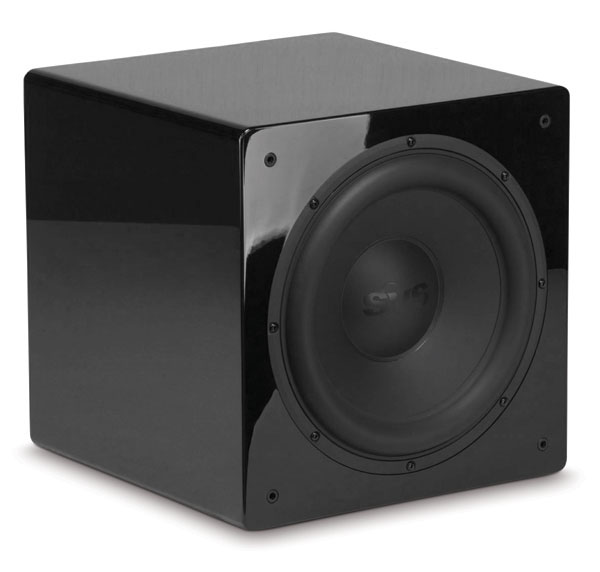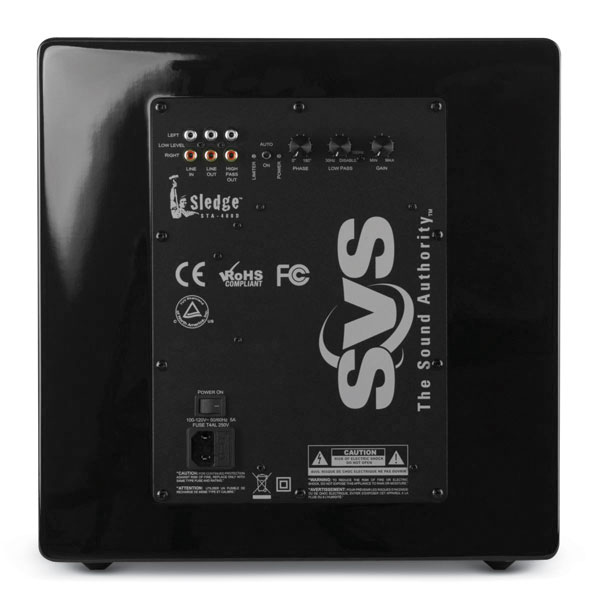I am thinking of trying this system out from SVS. My Paradigm Ref.20s ver 2 got wiped out from a tornado on Dec.26 in Garland,Tx. To replace all five including the Paradigm Ref CC it would cost me about double compared to the SVS Ultra system. I know you like Paradigm a lot and was wondering how you would compare these two brands. I am 50/50 music and HT. Thanks again for a thorough review.
SVS Ultra Speaker System Page 2
Great speakers get out of the way. The Ultras did it fast and consistently, ducking below the parapet at the start of the movie sessions and rarely peeping above it afterward with anything resembling an easy-to-describe personality. The sealed sub had enough output for my midsized room, though I had to increase the surround processor’s LFE setting a few decibels above the customary setting. The sub traded brute force for extension and evenness, behaving more like a musician than a blowhard. The crossover from sub to speakers was imperceptible except when I listened for it. I hesitate to apply any adjectives to the Bookshelf’s midrange because it provided such an unsmudged window into whatever the content and source component were offering at any given moment. The highs grew out of the mids naturally and transparently, and the net effect of all this was a kind of wholeness, a sense of unity and continuity, as opposed to just a bunch of drivers in wooden boxes.

The sonically eventful Life of Pi threw a variety of challenges at the Ultras. The opening music was lush and sweet—in fact, the Ultra monitor’s tweeter sounded more like I’m accustomed to from fabric domes, gentle and non-resonant, than can be the case with some aluminum domes. Satellites and sub worked together to make the storm-tossed ship a shockingly intense and violent event. They operated so seamlessly that I might have been listening to full-range towers and a multichannel muscle amp, as opposed to a monitors-and-sub system powered by a receiver. Later on, with the swirling all-channel music that accompanies Pi’s visions-at-sea experience, the system produced an almost hallucinogenic effect, a feeling continued in the subsequent scene of meerkat flocks in the jungle. Thanks to the Ultras, the movie’s soundtrack was as moving as its visuals.
The Ultra Center took the leading role in Silver Linings Playbook. Dialogue at every possible level came through with a natural feeling and a lack of obvious coloration. Again, the monitors and sub dovetailed beautifully, with localization of male voices in the sub as minimal as possible. Voices remained intelligible as I moved off axis. In the diner scene, the system handled the multichannel room ambience as well as it did the tumultuous dialogue (with Jennifer Lawrence memorably providing most of the tumult). The Ultra Surround blended well with the Bookshelf and Center. The soundtrack is studded with great musical moments from the Dave Brubeck Quartet, Bob Dylan, Johnny Cash, Frank Sinatra, Alabama Shakes, and others, and the Ultras invariably made them pleasurable to hear.
The Expendables 2—which fits more action stars into one movie than anything in Hollywood history: Stallone, Statham, Lundgren, blah, blah, blah—gave the Ultras their most action-rich workout. The speakers and sub couldn’t have done a better job with the barrage of shots, crashes, clatters, vrooms, collisions, slams, bams, pows, booms, biffs, etc. The sealed sub’s low-frequency treatment may not have been as aggressive as some, but I liked the way it reproduced controlled explosions, and its inherent musicality came in even handier during the subsequent music demos. The surround channels were ideally mated with the front channels. Surround effects didn’t call attention to themselves, but when the soundtrack called for all-channel ambience or a lateral surround pan, the surround speakers delivered.
From 5.1 to 2.0
Neil Young: Journeys, the Jonathan Demme film of a solo stand at Toronto’s Massey Hall, made the most of 5.1 as a music medium, and here the Ultra’s unity was at its most impressive. Young’s high, lonesome whine—still a young man’s voice in an old man’s body—was recorded from a mid-hall perspective with loads of surround ambience. The surround channels were also critical for spatial reproduction of roiling fuzztones and interestingly processed acoustic guitars. The Ultras worked as a single unit to reproduce this busy soundfield in a manner that was rich, immersive, and very un-speaker-bound. It was like being lost in a warm, churning ocean of sound (perhaps I was still visualizing Pi). What might have been sludge became magic, as the artist intended.
A system this good demanded vinyl, and the Ultra Bookshelf had enough bass to operate by itself, in the receiver’s 2.0 pure mode, most of the time. My pressing of Telemann’s Tafelmusik (“table music”) wears the gold-on-black Telefunken label from the 1960s, around the time of original release. The Concerto Amsterdam recording features Gustav Leonhardt on harpsichord, an instrument often rendered as a faint metallic tinkle. But through the Ultras, it was transformed (or restored) to a more spatially precise and timbrally rich sound, each note and chord wedded to its decay. The tonal balance of the strings was warm and woody. I love this record, and this reproduction of it was the best-case scenario.

Not for the first time recently, I turned to the Atlantic Records compilation The Jazz Years: 1948–1973, this time concentrating on the second of the two LPs. String bass is a good test of any monitor, and in this wide variety of recordings, the Ultras handled the instrument’s weight and proportioning well. Switching the receiver out of pure mode to the sub-enhanced stereo mode did little to diminish the basses: These speakers can do a lot without help from a sub. But from track to track, the basses did shift position from a spot smack between the speakers to a spot farther back, once again illustrating the Ultra’s ability to get out of the way and let the recording make its own spatial arrangements. The Bookshelf also brought out the ringing harmonics of Dwike Mitchell’s pounding repetitive piano solo in “The Catbird Seat” by the Mitchell-Ruff Trio.
I have the deepest respect for what SVS has done with the Ultra line, and for this listener, where respect treads, pleasure and relaxation are rarely far behind. These speakers do everything well, and the more time I spent with them, the more I appreciated the way they could get the best out of any content in my library—free of gross flaws, too-obvious subjectivity, or little niggling quirks that grow tiresome in the long term. The Ultra’s price/performance ratio is through the roof, and I recommend the line not only to those planning a purchase in this price category, but even to those who were planning to pay more. I don’t say this often, but I’ll say it now: I could live with these.
- Log in or register to post comments





































































